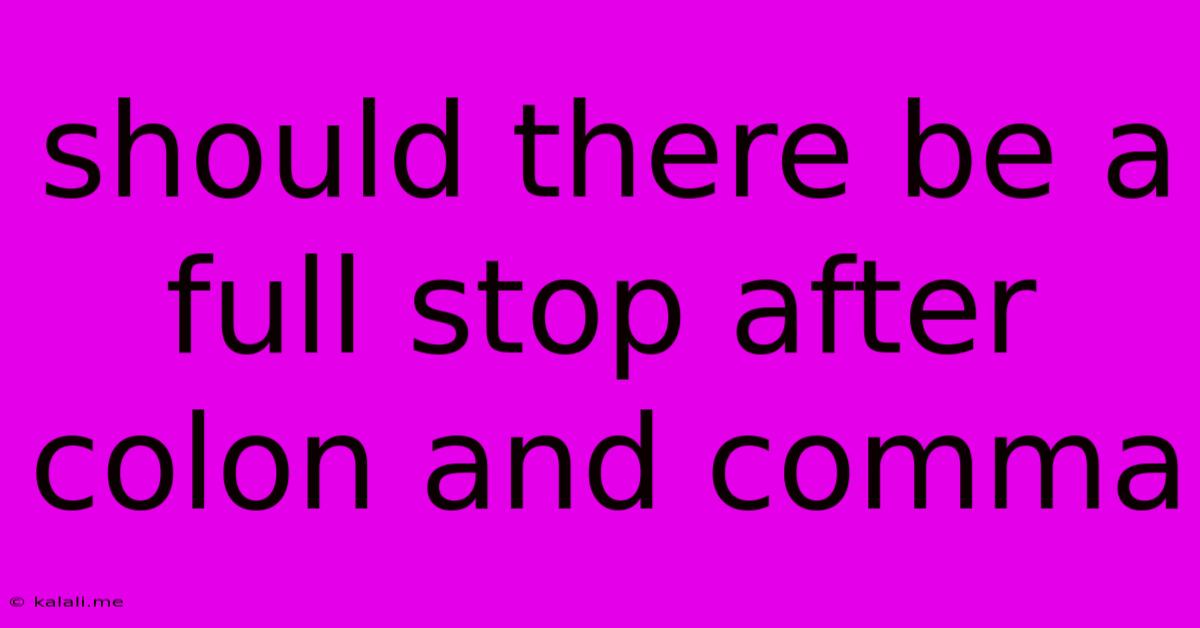Should There Be A Full Stop After Colon And Comma
Kalali
Jun 02, 2025 · 3 min read

Table of Contents
Should There Be a Full Stop After a Colon and a Comma?
The use of punctuation, specifically the full stop (period) after a colon and a comma, often causes confusion. This article clarifies the rules, offering clear examples and addressing common misconceptions to help you punctuate correctly and confidently. Understanding this will significantly improve the clarity and professionalism of your writing.
Understanding the Roles of Colons and Commas:
Before delving into whether a full stop should follow, let's refresh our understanding of colons and commas:
-
Colons (:) introduce an explanation, an example, a list, or a quotation. They signal a pause that is stronger than a comma but weaker than a full stop. They create a relationship between two independent clauses where the second clause elaborates on the first.
-
Commas (,) indicate a shorter pause and are used in various contexts, including separating items in a list, joining independent clauses with a coordinating conjunction (and, but, or, nor, for, so, yet), and setting off introductory elements.
Should a Full Stop Follow a Colon?
Generally, no, a full stop should not immediately follow a colon. The colon introduces a closely related element; therefore, a full stop would create an unnecessary and grammatically incorrect break. Instead, the sentence following the colon should continue the thought naturally.
Example:
- Incorrect: I have three favorite fruits: apples. Oranges. Bananas.
- Correct: I have three favorite fruits: apples, oranges, and bananas.
Sometimes, the element following the colon might be a complete sentence. In these cases, capitalization and punctuation follow standard rules:
Example:
- He gave one simple instruction: "Clean your room thoroughly."
Should a Full Stop Follow a Comma?
This depends entirely on the context. A full stop after a comma is incorrect if the comma is joining two clauses that should be grammatically connected. A full stop indicates the end of a complete sentence.
Example:
- Incorrect: I went to the store, I bought milk.
- Correct: I went to the store, and I bought milk. (using a coordinating conjunction)
- Correct: I went to the store. I bought milk. (two separate sentences)
However, if a comma is separating items in a list, or within a series of descriptive phrases, a full stop isn't needed.
Example:
- I packed my bag with essentials: a toothbrush, toothpaste, and a change of clothes.
Exceptions and Special Cases:
There are some specific cases where the rules might seem less straightforward. These often involve complex sentence structures and long lists. The key is maintaining grammatical clarity and logical flow. Always aim for sentences that are easy to understand and read. If you're unsure, breaking a long sentence into shorter, more concise ones is often the best approach.
Conclusion:
Mastering the correct use of colons and commas enhances the overall readability and professionalism of your writing. Remember, the colon generally doesn't require a full stop immediately following, while the need for a full stop after a comma depends on whether the comma separates complete sentences or parts of a single grammatical unit. Prioritize clarity and grammatical correctness to make your writing impactful and easy to understand. Using these rules effectively will make your writing stronger and more refined.
Latest Posts
Latest Posts
-
All Creative Works Are Not Finished But Abandoned
Jun 03, 2025
-
Pokemon White 2 Black 2 Rom
Jun 03, 2025
-
What Is A Good Box M Score
Jun 03, 2025
-
Smoke Alarm Still Beeping After Replacing Battery
Jun 03, 2025
-
How To Say I In Chinese
Jun 03, 2025
Related Post
Thank you for visiting our website which covers about Should There Be A Full Stop After Colon And Comma . We hope the information provided has been useful to you. Feel free to contact us if you have any questions or need further assistance. See you next time and don't miss to bookmark.